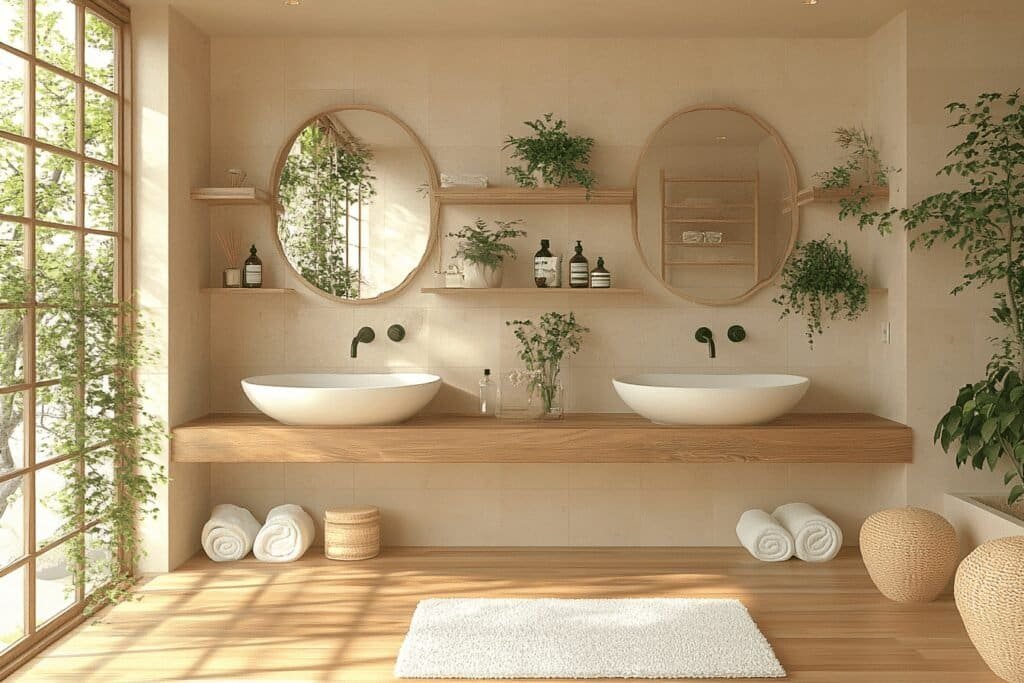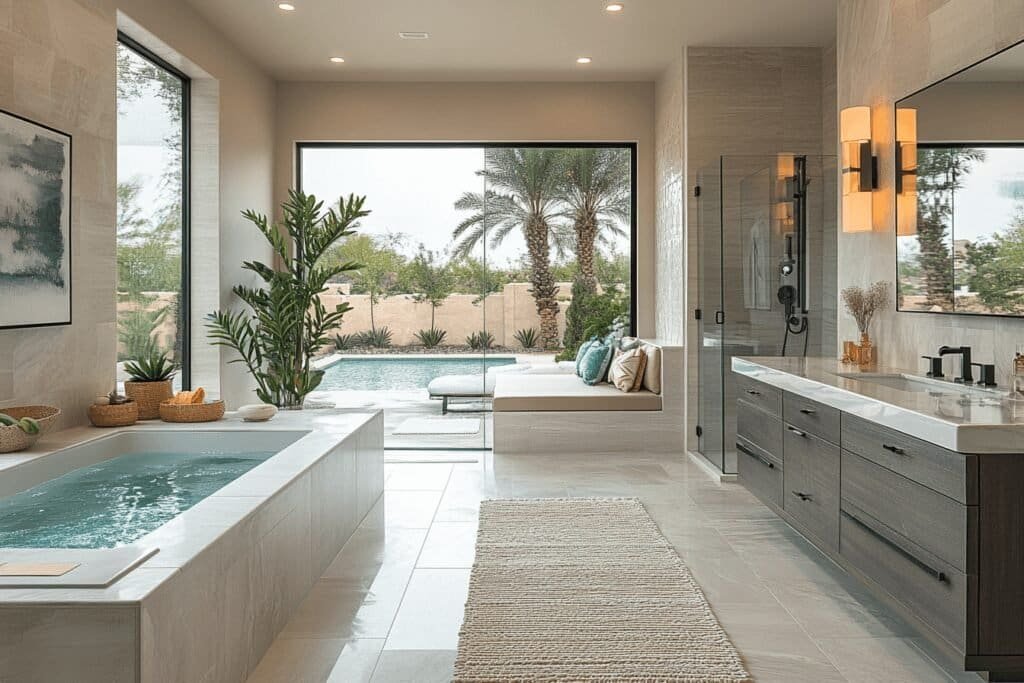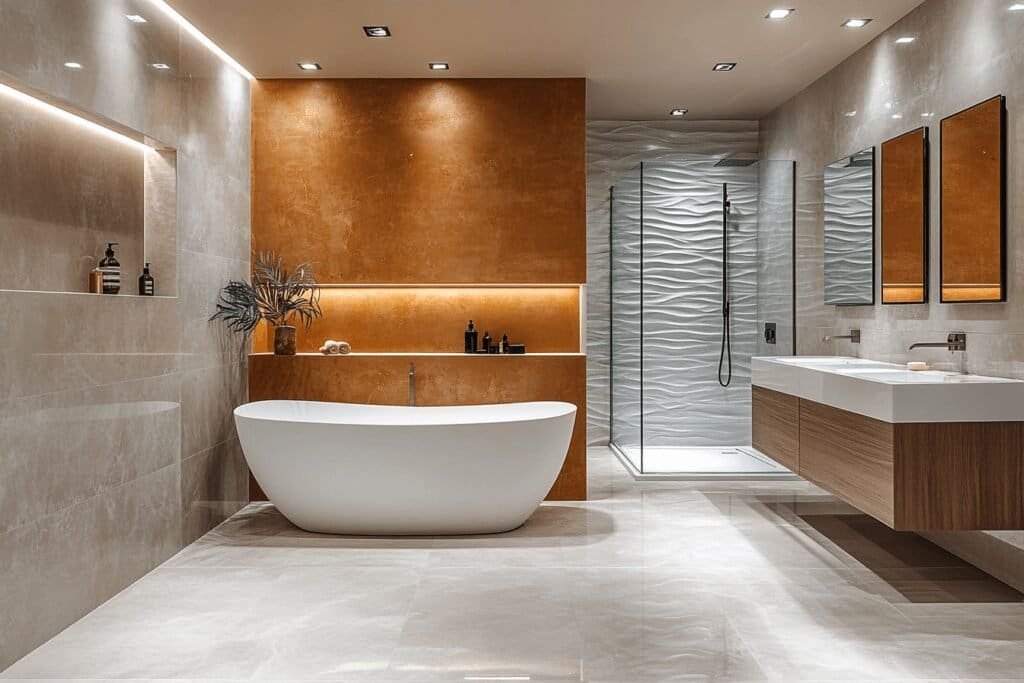The Japandi bathroom style has surged in popularity for its ability to blend the best of two distinct design philosophies: the minimalist calm of Japanese interiors and the cozy warmth of Scandinavian design. This harmonious mix—referred to as Japandi—brings serenity and simplicity to spaces, making it ideal for bathroom environments. A Japandi bathroom not only creates a sense of peace but also embodies functionality and natural beauty, a perfect recipe for a calming retreat.
Whether you’re planning a bathroom remodel or starting from scratch, this guide will walk you through everything you need to know about creating a Japandi-inspired space. Let’s dive into the key elements of Japandi bathroom design, explore essential decor ideas, and provide expert tips for transforming your bathroom into a sanctuary.
What is Japandi Bathroom? A Fusion of Japanese and Scandinavian Minimalism
Japandi design is a fusion of Japanese minimalism, known for its clean lines and Zen-like simplicity, and Scandinavian design, which emphasizes warmth, coziness, and functionality. Both styles share a love for neutral color palettes, natural materials, and uncluttered spaces.
In the bathroom, Japandi creates an environment where beauty meets function. The style aims to strip away excess while maintaining a warm, welcoming atmosphere. This balance is achieved through simple, elegant forms, natural textures, and a focus on mindfulness in design.
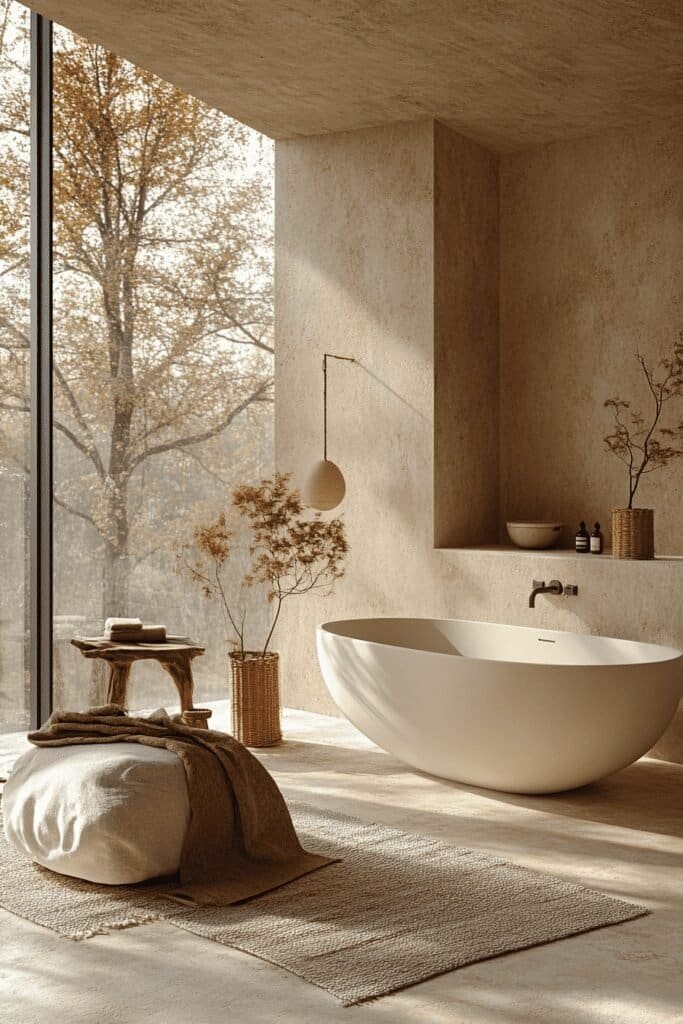

Why Choose Japandi Bathroom for Your Remodel?
When considering a bathroom remodel, Japandi is a top choice for homeowners looking to create a serene and timeless space. The minimalist approach reduces visual clutter, which is essential for a calm, relaxed environment. Japandi also embraces the concept of “wabi-sabi,” a Japanese idea that values imperfection and authenticity, which pairs well with Scandinavian coziness (Hygge).
Additionally, Japandi’s focus on functionality and simplicity makes it suitable for both large and small bathrooms. Even a compact space can feel open and peaceful with the right layout, materials, and colors.
Essential Elements of Japandi Bathroom Design
To create a Japandi bathroom, it’s crucial to understand the key elements that define this style. These foundational aspects help you design a space that radiates tranquility and sophistication.
1. Minimalism and Simplicity
At its core, Japandi emphasizes simplicity. Keep your bathroom design free from unnecessary ornamentation. Focus on clean lines, simple shapes, and an uncluttered environment. Choose fixtures that are both beautiful and functional, avoiding over-complication in layout and design.
2. Natural Materials
One of the hallmarks of Japandi design is the use of natural materials. Wood is particularly important, offering warmth to balance the minimalist aesthetic. You can use wooden accents in vanity units, shelving, or even bathmats. Stone, bamboo, and ceramics are also key elements, helping to ground the space in natural textures.
3. Neutral Color Palette
Japandi bathrooms rely on neutral tones to create a calm and balanced atmosphere. Think soft beiges, whites, light greys, and muted earth tones. These colors evoke the simplicity of nature and allow the materials themselves to shine without distraction.
4. Functional Storage Solutions
Clutter has no place in a Japandi bathroom. Invest in smart, space-saving storage options like recessed cabinets, hidden shelves, and under-vanity storage. These solutions keep your essentials accessible but out of sight, maintaining the bathroom’s sleek, minimal appearance.
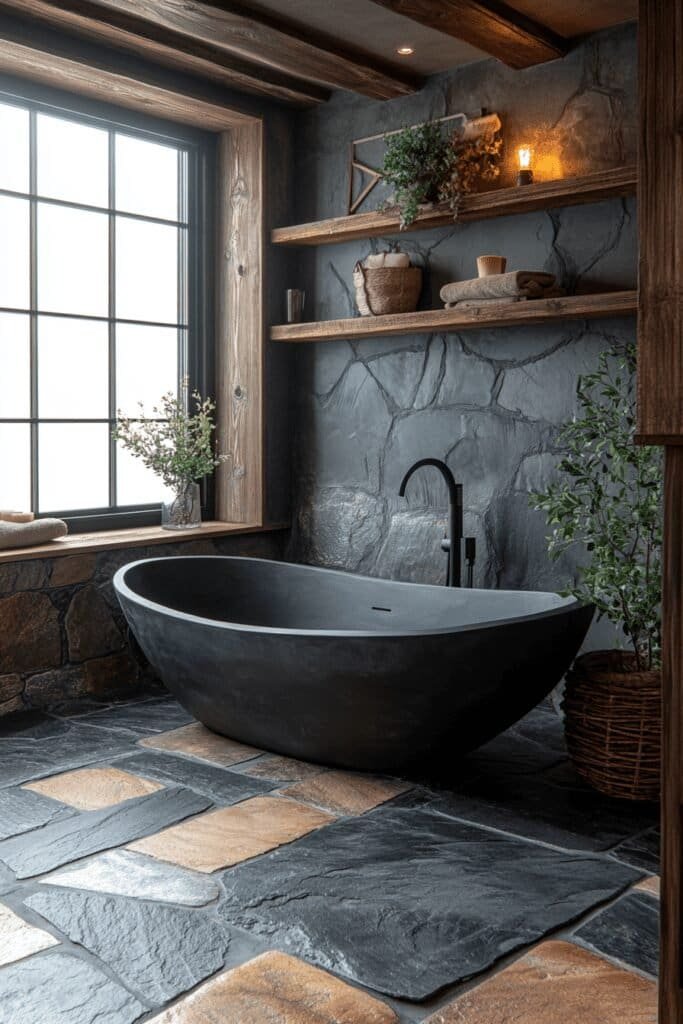

Key Features of Japandi Bathroom Design
In addition to the key elements mentioned above, there are specific design features that are essential for a Japandi bathroom.
1. Bathtubs
Freestanding, deep soaking tubs are a signature feature in Japanese bathrooms, and they translate beautifully into Japandi design. These tubs offer a luxurious way to unwind, providing a focal point in the bathroom that invites relaxation.
2. Showers
A walk-in shower with frameless glass is ideal for a Japandi bathroom. The clean lines of the glass create an open, airy feel while maintaining simplicity in the design.
3. Bathroom Fixtures
Opt for sleek, matte black or brass faucets and showerheads to keep the fixtures minimalist yet striking. These finishes complement the natural materials used in the bathroom, enhancing the overall aesthetic without overpowering it.
4. Lighting
Lighting plays a crucial role in creating the cozy, calming ambiance Japandi design is known for. Incorporate soft, natural lighting wherever possible. Warm, dimmable lights add a touch of coziness, while pendant lights or simple wall sconces can enhance the minimalist feel.
Incorporating Texture for a Balanced Japandi Bathroom Design
While Japandi design is minimalist, it doesn’t mean it has to be cold or sterile. Texture plays an essential role in adding warmth and depth to the space without overwhelming the simplicity of the design. The contrast between smooth, sleek surfaces and natural, tactile materials creates an inviting atmosphere.
Wood and Stone Contrasts
Incorporating wooden elements such as oak or bamboo alongside cool stone, like granite or marble, adds both visual and tactile contrast. For instance, a freestanding stone sink paired with a wooden vanity can elevate the sense of tranquility, connecting the bathroom to nature.
Textured Fabrics and Decor
Consider soft, textured fabrics like woven rugs, cotton towels, or linen window coverings. Subtle additions, such as ceramic vases or stone trays, can also enhance the design, bringing balance to the room by combining soft and hard elements.
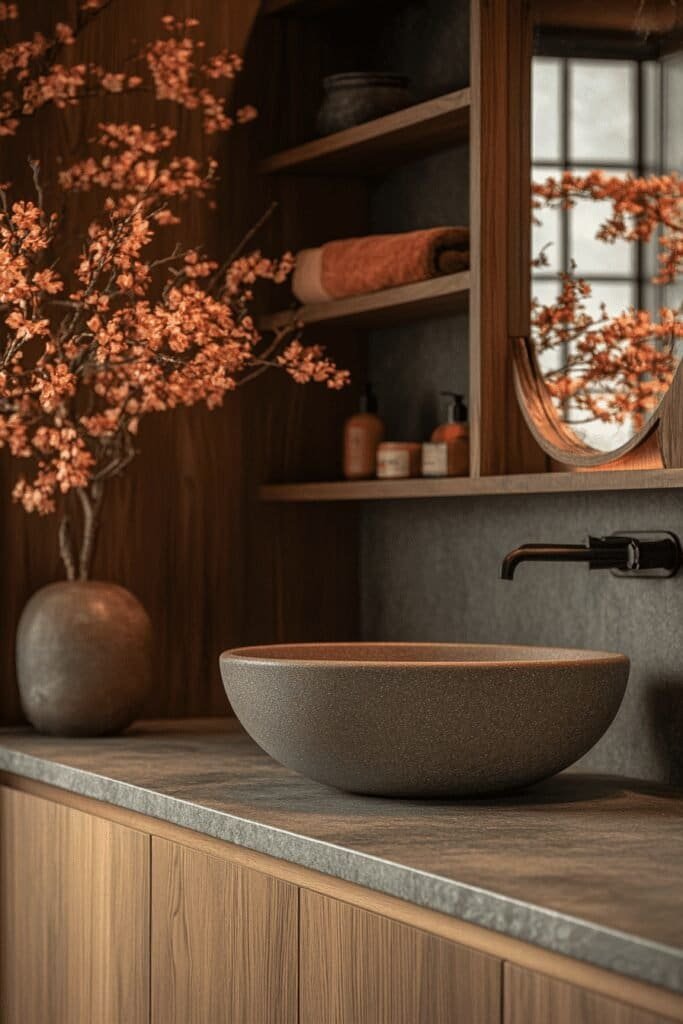

The Role of Nature in Japandi Bathroom
Nature plays a central role in Japandi bathroom design, reflecting the Japanese appreciation for natural elements and the Scandinavian love of light, airy spaces. Introducing plants into your bathroom is a great way to add life and warmth.
Incorporating Plants
Minimalist pots with simple greenery, such as bamboo, ferns, or succulents, bring a fresh, natural element into the bathroom. These plants thrive in humid environments and add a touch of organic texture, softening the clean lines of the room.
Natural Light
Maximizing natural light is essential. If your bathroom has a window, consider using sheer blinds or no coverings at all to let in as much light as possible. Natural light makes the space feel more open, promoting relaxation and enhancing the materials and colors in the room.
Sustainability in Japandi Bathroom Design
Japandi design is not just about aesthetics; it’s also rooted in sustainability. Both Japanese and Scandinavian cultures emphasize mindfulness, minimalism, and respect for nature. This approach translates into the materials and products chosen for a Japandi bathroom remodel. Using eco-friendly materials such as reclaimed wood, bamboo, and energy-efficient fixtures can enhance the bathroom’s aesthetic while being environmentally conscious.
Opt for natural stone or recycled materials for countertops, and choose water-saving fixtures like low-flow toilets and faucets to reduce water consumption. For lighting, energy-efficient LED lights and large windows that allow natural light to flood the space will help reduce energy use. By focusing on sustainability, you’re not only creating a serene and beautiful bathroom but also contributing to a greener lifestyle.
Integrating Sustainable Decor
Sustainability also extends to decor elements in Japandi design. For example, rather than opting for synthetic textiles, choose organic cotton towels or bamboo bath mats. Similarly, decor pieces made from recycled or upcycled materials—like wooden shelves or ceramic planters—can add character to your bathroom while reducing your environmental footprint.
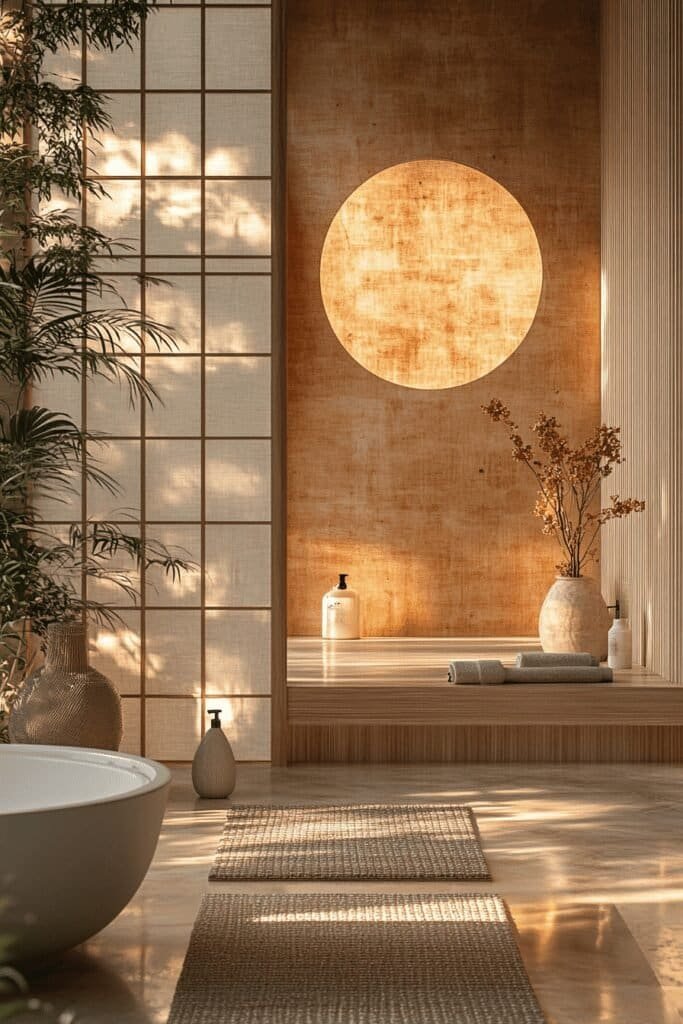

Creating a Zen-like Experience: Japandi Bathroom Decor Ideas
Once the foundational elements are in place, you can add finishing touches to elevate the design. The right decor can transform your bathroom into a peaceful sanctuary.
1. Woven Textiles and Wooden Bath Mats
Incorporate soft, woven textiles such as bath towels or cotton bathrobes in neutral tones. Pair them with wooden bath mats to maintain a seamless connection between natural materials.
2. Stone Trays and Ceramic Accessories
Use stone trays and simple ceramic containers to hold bathroom essentials like soap or toothbrushes. These accessories complement the minimalist aesthetic while keeping things organized.
3. Minimalistic Art
Choose a few minimalistic art pieces that reflect nature or simple forms. A small, neutral-colored painting or a framed print with a Japanese-inspired design can subtly enhance the serenity of the space.
How to Incorporate Technology in a Japandi Bathroom
While Japandi design embraces natural elements and simplicity, it doesn’t shy away from modern technology. The key is to integrate tech seamlessly, so it doesn’t interfere with the minimalist look and feel of the bathroom. This can be done through sleek, high-tech features that add both functionality and style.
Smart Bathroom Fixtures
Consider installing smart bathroom features, such as digital showers that allow you to control water temperature and pressure at the touch of a button. Heated floors, a popular feature in Scandinavian homes, can be programmed to turn on and off according to your schedule, ensuring warmth without wasting energy.
Minimalist Tech Solutions
Smart mirrors with integrated lighting and anti-fog features are also popular in Japandi bathroom design. These mirrors maintain the minimalist look while adding a touch of modern convenience. A smart toilet with a bidet function can also blend well with the Japandi aesthetic, offering comfort and hygiene without sacrificing design integrity.
Remodeling Your Bathroom into a Japandi Haven: A Step-by-Step Guide
Here’s a step-by-step approach to remodeling your bathroom into a Japandi-inspired haven:
Step 1: Declutter Your Space
Remove any unnecessary items to create a clean and open environment.
Step 2: Choose Natural Materials
Incorporate wood, stone, and bamboo wherever possible for a natural, calming feel.
Step 3: Stick to Neutral Colors
Paint the walls in soft beige, white, or light grey tones to maintain the minimalist aesthetic.
Step 4: Invest in Functional Storage
Install recessed cabinets and hidden storage to keep the space organized and uncluttered.
Expert Opinion on Japandi Bathroom Design
“Japandi strikes the perfect balance between warmth and minimalism, which is exactly what a bathroom needs,” says Emma Collins, an interior designer known for her modern, serene spaces. “The combination of natural materials, functional storage, and calming colors ensures that your bathroom remains a place of relaxation and mindfulness.”
How Japandi Bathroom Design Fits into Modern Homes
Japandi design is especially suited to modern homes because of its simplicity and emphasis on functionality. Its minimalist approach complements modern architectural styles, and its versatility means it can work in both large, luxurious master bathrooms and compact, urban spaces.
Bringing Japandi Design into Communal or Commercial Spaces
While Japandi design is perfect for private, residential bathrooms, its principles can also be successfully applied to commercial or communal spaces such as spas, boutique hotels, or even cafes. Its calming, nature-inspired aesthetic is well-suited to public environments where the aim is to create a tranquil atmosphere.
In a spa bathroom, Japandi design elements can create a serene environment that encourages relaxation. Neutral color palettes and the use of wood and stone can give the space a Zen-like feel. Similarly, restaurants or cafes can incorporate Japandi-inspired bathrooms to enhance the overall dining experience, providing a clean, peaceful break from the busy dining area.
Japandi’s simplicity and focus on functionality make it adaptable to both large and small spaces, making it an ideal design choice for communal and commercial environments.
Final Thoughts: Embrace Japandi for a Relaxing, Timeless Bathroom Design
A Japandi bathroom is more than just a trend—it’s a design philosophy rooted in simplicity, nature, and balance. Whether you’re undergoing a full bathroom remodel or just making a few changes, embracing Japandi principles will help you create a calming, serene space that stands the test of time.
Frequently Asked Questions (FAQs)
Q1: What colors should I use for a Japandi bathroom?
Stick to neutral tones like beige, white, grey, and soft earthy colors to create a calming, balanced atmosphere.
Q2: Is Japandi suitable for small bathrooms?
Yes! Japandi’s minimalist design makes it perfect for small bathrooms by reducing clutter and maximizing natural light.
Q3: What materials are ideal for Japandi bathroom design?
Natural materials like wood, stone, bamboo, and ceramics are essential in Japandi design.
Q4: Can I mix Japandi with other styles?
Yes! Japandi blends well with other minimalist styles like modern and Scandinavian design.
Q5: How do I create a Japandi-inspired bathroom on a budget?
Focus on natural materials, simple decor, and DIY storage solutions to achieve the look without overspending.
Disclaimer: As an Amazon Associate, I earn from qualifying purchases. This means that if you click on certain links on this site and make a purchase, I may receive a small commission at no additional cost to you.
